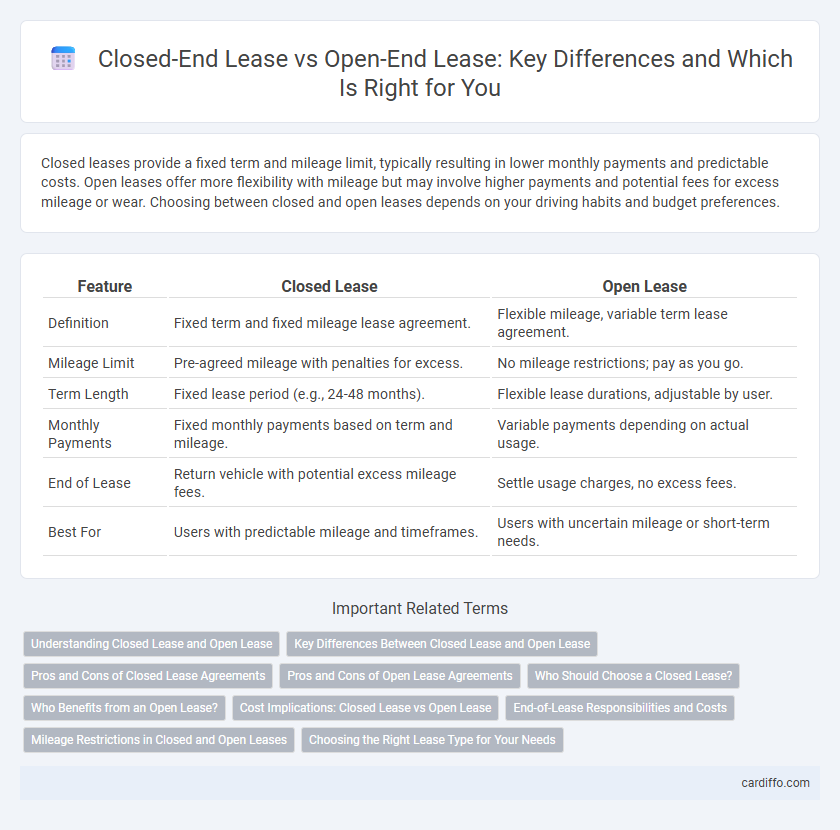Closed leases provide a fixed term and mileage limit, typically resulting in lower monthly payments and predictable costs. Open leases offer more flexibility with mileage but may involve higher payments and potential fees for excess mileage or wear. Choosing between closed and open leases depends on your driving habits and budget preferences.
Table of Comparison
| Feature | Closed Lease | Open Lease |
|---|---|---|
| Definition | Fixed term and fixed mileage lease agreement. | Flexible mileage, variable term lease agreement. |
| Mileage Limit | Pre-agreed mileage with penalties for excess. | No mileage restrictions; pay as you go. |
| Term Length | Fixed lease period (e.g., 24-48 months). | Flexible lease durations, adjustable by user. |
| Monthly Payments | Fixed monthly payments based on term and mileage. | Variable payments depending on actual usage. |
| End of Lease | Return vehicle with potential excess mileage fees. | Settle usage charges, no excess fees. |
| Best For | Users with predictable mileage and timeframes. | Users with uncertain mileage or short-term needs. |
Understanding Closed Lease and Open Lease
Closed lease agreements specify fixed terms, including lease duration, mileage limits, and end-of-lease conditions, providing clarity on costs and penalties for excess usage. Open lease contracts offer flexibility with variable lease periods and no predefined mileage caps, allowing lessees to adjust terms according to changing needs but potentially incurring higher costs. Understanding the distinctions between closed and open leases helps consumers select options aligned with their usage patterns and financial planning.
Key Differences Between Closed Lease and Open Lease
Closed leases feature fixed terms and mileage limits, providing predictable monthly payments and costs at lease-end. Open leases lack mileage restrictions, allowing flexibility but may involve variable fees or higher payments based on actual vehicle usage. The main differences hinge on financial predictability versus usage flexibility and potential end-of-lease charges.
Pros and Cons of Closed Lease Agreements
Closed lease agreements offer fixed terms and predetermined mileage limits, providing predictability and often lower monthly payments compared to open leases. However, exceeding the mileage allowance or incurring excessive wear and tear can result in additional charges at the end of the lease, increasing overall costs. This type of lease benefits lessees who have a clear understanding of their driving habits and prefer financial certainty throughout the lease term.
Pros and Cons of Open Lease Agreements
Open lease agreements offer flexibility by allowing lessees to modify or terminate the lease before the contract ends, which benefits businesses with fluctuating needs. They typically require lower upfront costs and provide financial adaptability but pose risks of higher long-term expenses due to variable payments. However, the uncertainty of future lease terms and potential for increased total costs may deter lessees seeking predictable financial commitments.
Who Should Choose a Closed Lease?
A closed lease is ideal for individuals who prefer predictable monthly payments and intend to keep the vehicle for the full lease term, especially when annual mileage is unlikely to exceed set limits, typically ranging from 10,000 to 15,000 miles per year. This lease type minimizes end-of-term financial surprises, as excess mileage penalties and wear-and-tear charges are defined upfront. Optimal for budget-conscious lessees with stable driving habits, closed leases provide certainty and protection against variable costs.
Who Benefits from an Open Lease?
An open lease benefits lessees who anticipate fluctuating mileage, offering flexibility without penalties for exceeding pre-set limits. This lease type suits businesses with variable vehicle usage or individuals unsure about long-term driving needs. Lessors also gain from open leases through higher residual value risk, often resulting in slightly higher monthly payments compared to closed leases.
Cost Implications: Closed Lease vs Open Lease
Closed leases typically involve fixed monthly payments based on predetermined mileage limits and vehicle condition, minimizing unexpected costs at lease end. Open leases offer more flexible terms but can result in higher overall expenses due to mileage overages and wear-and-tear charges. Evaluating the total cost of ownership, including potential penalties, is essential when comparing closed and open lease agreements.
End-of-Lease Responsibilities and Costs
Closed leases have fixed terms and mileage limits, making end-of-lease responsibilities more predictable, with lessees typically paying fees for excess wear or mileage overages. Open leases offer flexibility in duration and usage but can result in uncertain end-of-lease costs, as lessees may face higher fees for early termination or excessive wear. Understanding these differences helps lessees manage potential end-of-lease costs and obligations effectively.
Mileage Restrictions in Closed and Open Leases
Closed leases impose strict mileage limits, typically ranging from 10,000 to 15,000 miles per year, with penalties for exceeding the agreed-upon mileage. Open leases offer more flexibility, allowing lessees to exceed mileage caps without immediate penalties, but usually result in higher monthly payments or purchase price adjustments at lease-end based on actual mileage. Understanding the financial implications of mileage restrictions in closed versus open leases is crucial for managing lease costs effectively.
Choosing the Right Lease Type for Your Needs
Closed Lease offers fixed payments and mileage limits ideal for predictable usage, while Open Lease provides flexibility without mileage restrictions but may incur higher costs. Selecting the right lease depends on factors like anticipated vehicle usage, budget constraints, and preferences for mileage control. Evaluating your driving habits and financial plans ensures the lease type aligns with your specific needs and avoids unexpected expenses.
Closed Lease vs Open Lease Infographic

 cardiffo.com
cardiffo.com